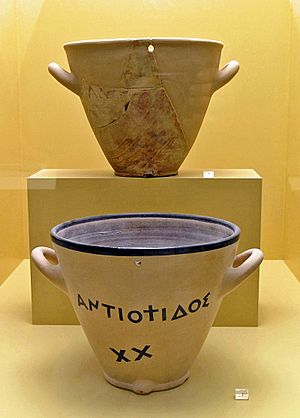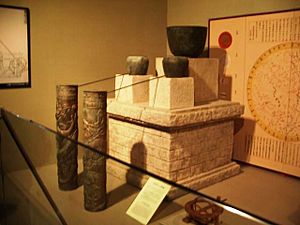Water clock facts for kids
A water clock or clepsydra is a special device that measures time. It works by letting liquid flow into or out of a container at a steady speed. You can then measure how much liquid has moved to tell how much time has passed.
Water clocks are some of the oldest tools ever used to measure time! The simplest kind, which looked like a bowl with water flowing out, was used in Babylon, Egypt, and Persia around 1600 BC. Other places like India and China also used water clocks very early on, but we're not as sure about the exact dates. People in ancient Greece and ancient Rome also used them, and famous writers like Ctesibius and Vitruvius wrote about them.
Contents
How Water Clocks Work
A water clock uses the steady flow of water to tell time. Imagine a container with water. There are two main ways they work:
- Outflow Water Clock: Water slowly drains out of a container. The container has lines marked on the inside. As the water level drops, you can see which line it's at to know how much time has passed.
- Inflow Water Clock: Water slowly fills up a container that has markings. As the container fills, you can see where the water reaches the lines to tell the time.
Some modern clocks are called "water clocks" but they work differently. They might use water to power the clock's movement, like with a water wheel, or just for a cool display.
People in ancient Greece and Rome made water clocks much better. They added things like gears and special parts that made the clocks more accurate. They even connected them to cool moving figures called automata! Later, people in places like Byzantium and the Middle East made even more advanced water clocks with complex gears and even ways to program them. These ideas eventually reached Europe. At the same time, the Chinese also developed their own advanced water clocks with gears and water wheels, and shared these ideas with Korea and Japan.
Early water clocks were often checked and set using a sundial. Even though they weren't as super accurate as today's clocks, water clocks were used for thousands of years until mechanical clocks became popular around the 1300s.
Water Clocks Around the World
Egypt
The oldest physical proof of a water clock comes from Egypt, around 1417–1379 BC. It was found in the Temple of Amen-Re at Karnak. The oldest written record about a water clock is from the 16th century BC, mentioning an Egyptian official named Amenemhet as its inventor.
These early Egyptian water clocks were simple stone bowls with sloped sides. Water would slowly drip out from a small hole at the bottom. Inside, there were twelve columns of markings. Each column was for a different month of the year. This was because the length of "hours" changed with the seasons back then. Priests used these clocks at night to make sure temple ceremonies happened at the right time.
Babylon
Quick facts for kids Clay tablet |
|
|---|---|
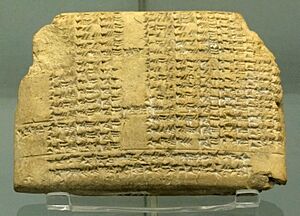
This clay tablet shows calculations for a water clock, made by Nabû-apla-iddina.
|
|
| Size | H:8.2 cm (3.2 in) W:11.8 cm (4.6 in) D:2.5 cm (0.98 in) |
| Writing | cuneiform, Akkadian |
| Created | 600BC-500BC |
| Present location | Room 55, British Museum |
| Identification | 29371 |
In Babylon, water clocks were shaped like cylinders and water flowed out of them. People in Babylon used water clocks to help with astronomy calculations as far back as 2000–1600 BC. We don't have any Babylonian water clocks left, but we know about them from writings on clay tablets. These tablets mention water clocks being used to time the shifts of night and day guards.
Babylonian water clocks were special because they didn't have pointers or markings like Egyptian ones. Instead, they measured time by the weight of the water that flowed out! The amount of water was measured in units called qa, and its weight was measured in mana.
Since the length of a day changed with the seasons in Babylon, the amount of water needed to mark a "watch" (a period of time) also changed. For example, during the summer, you'd pour a certain amount of water for a night watch. As the seasons changed, you'd add or subtract water to keep the time accurate.
India
Some experts believe water clocks were used in ancient India as early as 2000 BC, based on old writings. Pots found at the Indus Valley site of Mohenjo-daro might have been used as water clocks. They have a hole on the side and are shaped like vessels used for pouring water in religious ceremonies.
The Jyotisha school, which studied astronomy, described water clocks called ghati or kapala. These measured time in units called nadika, which is about 24 minutes. A copper bowl that floated and then sank when full was described in a 5th-century AD text. At Nalanda, a famous Buddhist university, students used a water clock with a similar copper bowl that sank when full. When it sank, a drum was beaten to mark the time.
China
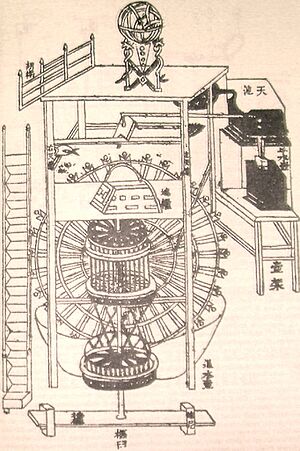
In ancient China and other parts of East Asia, water clocks were super important for studying astronomy and astrology. The first written mention of water clocks in China is from the 6th century BC. Around 200 BC, the Chinese mostly switched from outflow water clocks to inflow ones, which had a floating rod to show the time.
A Han dynasty philosopher named Huan Tan (40 BC – AD 30) noticed that temperature and humidity affected how accurate water clocks were. This shows that people back then knew about how evaporation and temperature could change how fast water flowed. Freezing was also a problem for water clocks. In 976, a Chinese astronomer named Zhang Sixun solved this by using mercury instead of water, because mercury stays liquid at much colder temperatures. Later, engineers even made clocks powered by sand instead of water!
Chinese inventors like Zhang Heng (78–139) in 117 AD started using water clocks to power moving models that showed how the stars and planets moved. Zhang Heng was also the first in China to add an extra tank to keep the water pressure steady, which made the clocks more accurate. Later, in 725, engineers Yi Xing and Liang Lingzan created a clock powered by a waterwheel with a special "escapement" mechanism. This same idea was used by Su Song (1020–1101) in 1088 to power his incredible astronomical clock tower.
Su Song's clock tower was over 30 feet (9.1 m) tall! It had a bronze model of the sky that moved, a rotating celestial globe, and five doors that opened to show figures ringing bells or gongs and holding signs with the time. Today, you can still see an outflow water clock working in Beijing's Drum Tower. It's connected to moving figures that clap cymbals every 15 minutes!
Persia
Water clocks have been used in Persia (modern-day Iran) for a very long time, especially in desert areas like Yazd and Gonabad. They date back to 500 BC! People used them to figure out the exact dates for important religious holidays like Nowruz (the spring equinox) and Yaldā Night (the winter solstice).
These Persian water clocks were super important for farmers. They helped them measure how long they could take water from a qanat (an underground water channel) or a well for their farms and gardens. Since water was so precious in the desert, it was very important to share it fairly. So, a wise old person called a Mir Aab was chosen to manage the water clock. They would watch the clock and announce the exact time from sunrise to sunset.
The Persian water clock, called a Fenjaan, was a large pot full of water with a smaller bowl that had a tiny hole in its center. When the small bowl filled with water, it would sink. The manager would then empty the bowl and put it back on the water. They kept track of how many times the bowl sank by putting small stones into a jar. The place where the clock was kept was called khaneh Fenjaan (times house). The Zibad Gonabad water clock was used until 1965, when modern clocks took over.
Greco-Roman World

The word "clepsydra" comes from Greek and means "water thief." The Greeks made water clocks much better by solving the problem of the water flow slowing down as the container emptied. They invented different types of inflow water clocks, including one with an early feedback system to keep the flow steady. Ctesibius invented a system with a dial and pointer, similar to later clocks. The Roman engineer Vitruvius even described early alarm clocks that used gongs or trumpets!
A common water clock was a simple outflow clepsydra, a small clay pot with a hole near the bottom. In both Greek and Roman times, these were used in courts to time how long speakers could talk. For important cases, the pot was filled completely. If someone needed to pause, like to look at documents, the hole was stopped with wax until they could continue.
Water Clocks for Everyday Use
In the early 3rd century BC, a Greek doctor named Herophilos used a portable water clock during his house visits in Alexandria. He used it to measure his patients' pulse beats! By comparing the pulse rate to what was normal for different age groups, he could tell how serious an illness was.
Between 270 BC and 500 AD, Greek and Roman clockmakers and astronomers created more complex mechanical water clocks. They wanted to control the water flow better and create fancier ways to show the time. Some water clocks rang bells and gongs, while others opened doors to show little figures or moved pointers on dials. Some even showed models of the universe! An engineer named Philo of Byzantium (3rd century BC) wrote about water clocks that already had an "escapement mechanism," which was a very early version of this important clock part.
One of the biggest achievements was by Ctesibius, who added gears and a dial to his water clocks. This allowed them to automatically show the time even as the length of days changed throughout the year. Also, a Greek astronomer named Andronicus of Cyrrhus built the Horologion, also known as the Tower of the Winds, in Athens around the 1st century BC. This eight-sided tower had sundials and a windvane outside. Inside, it had a mechanical water clock, though we're not sure exactly how it displayed the time. It might have had a rod that moved up and down, a water-powered figure that struck a bell, or a moving star disk on the ceiling.
Medieval Islamic World
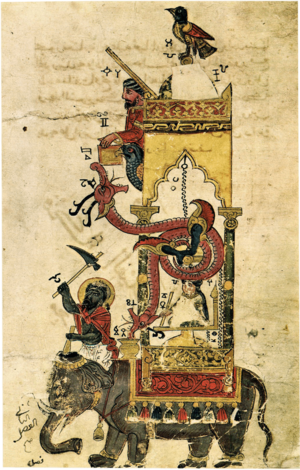
In the medieval Islamic world (632-1280), people continued to use and improve water clocks. The water clocks made by the Arabic engineer Al-Jazari are famous for being much more advanced than anything before them. In his book from 1206, Al-Jazari described his incredible elephant clock. This clock could keep track of "temporal hours," meaning it could adjust for the changing length of days throughout the year. It had two tanks: the top one was connected to the time-telling parts, and the bottom one helped control the water flow.
Al-Jazari's most complex water-powered clock was his castle clock from 1206. Some people even call it an early example of a programmable analog computer! It was about 11 feet (3.4 m) tall and did many things besides just telling time. It showed the zodiac signs and the paths of the sun and moon. A pointer shaped like a crescent moon moved across a gateway, opening automatic doors every hour to show a little figure. You could even reprogram it to match the changing lengths of day and night throughout the year. It also had five musician figures that played music automatically, moved by levers connected to a water wheel.
Earlier, around 1000 AD, an Arab engineer named Ibn Khalaf al-Muradi in Islamic Spain invented the first water clocks that used complex gears. His water clocks were powered by water wheels, just like some Chinese water clocks in the 11th century. Similar water clocks were built in Damascus and Fez. The one in Fez still exists today! The first European clock to use these complex gears was an astronomical clock made by Giovanni de Dondi around 1365. Like the Chinese, Arab engineers also developed an "escapement" mechanism for some of their water clocks.
Korea
In 718, Unified Silla (an ancient Korean kingdom) started using water clocks, inspired by the Tang Dynasty in China. Later, in 1434, during the Joseon period, a brilliant engineer named Jang Yeong-sil built the Jagyeongnu for King Sejong. This was a self-striking water clock!
What made the Jagyeongnu "self-striking" was that it used wooden figures (called "jacks") that would automatically hit objects to signal the time. This meant that people didn't need to constantly watch and refill the clock anymore.
This clock was special because it could announce two types of time automatically, with both visual signals and sounds. Jang Yeong-sil invented a way to convert the analog time (measured by water) into digital time (announced by the figures). This special device was called pangmok. The Striking Palace Clepsydra is considered the first clock in history to use water power and mechanics to tell two kinds of time at once!
Japan
Emperor Tenji created Japan's first water clock, called a Rokoku. These clocks were very important in society and were managed by special experts called "Doctors of Water Clock."
Water Clocks and Temperature
One challenge with water clocks is that the temperature of the water can affect how accurate they are. When water gets warmer, it flows a bit faster because it becomes less thick (less "viscous"). When it's colder, it flows slower. For example, water flows about seven times faster at 100°C (boiling) than at 0°C (freezing).
Even a small change in temperature, like just one degree Celsius, can make a water clock gain or lose about half an hour a day! To keep time within one minute a day, the temperature would need to be controlled very, very carefully. We don't have proof that ancient people did this.
However, ancient water clocks were probably reset every day, often using a sundial. So, even if they weren't perfectly accurate on their own, any errors wouldn't build up too much over time.
See also
- Bernard Gitton
- History of timekeeping devices
- Hourglass


